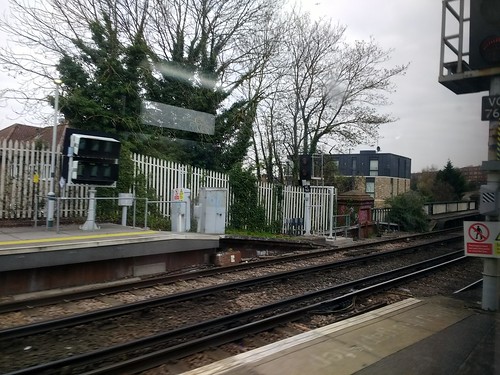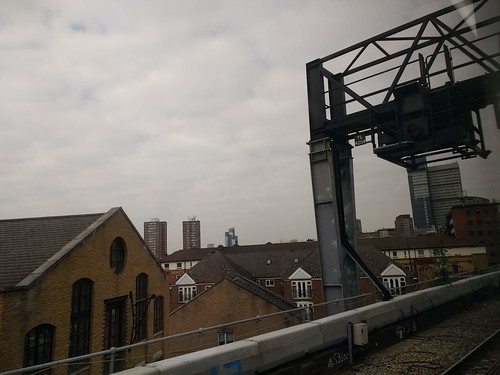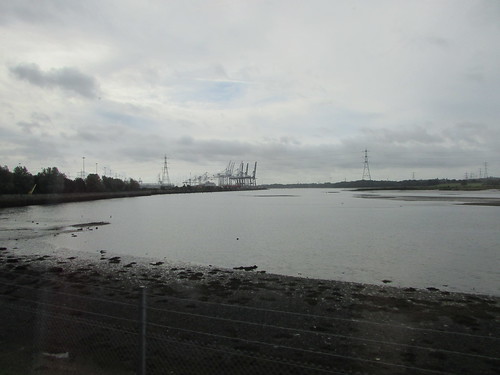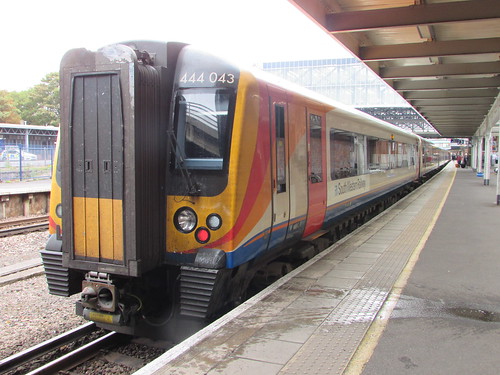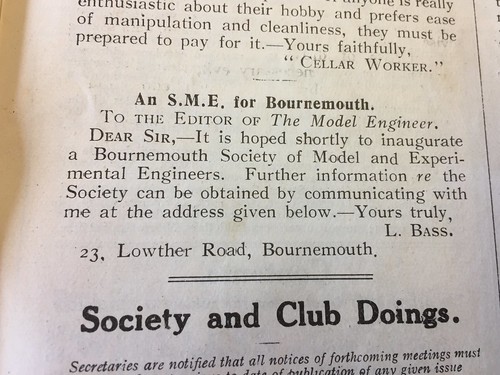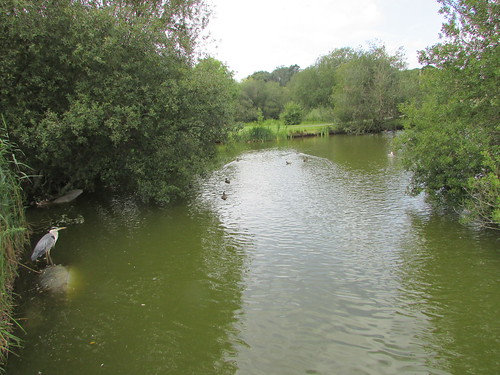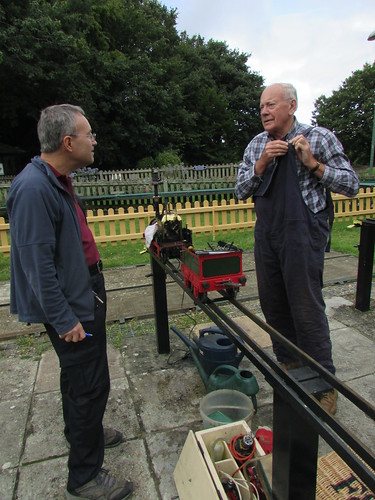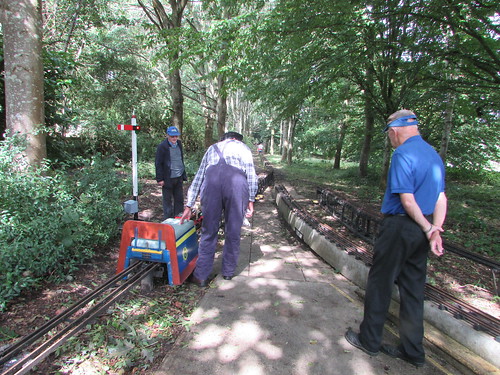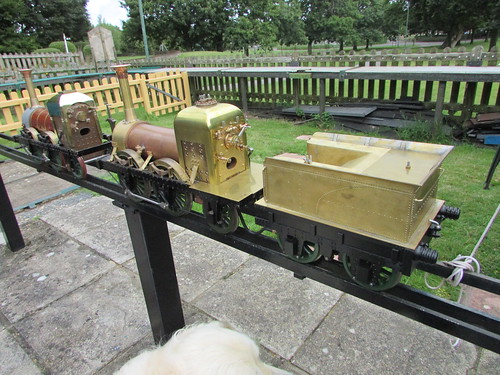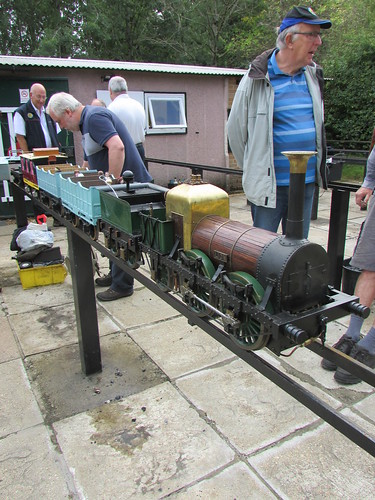As I approached the Locomotive Shed on Saturday morning, I was musing whether to oil round the outside motion first or immediately tackle the oiling points accessible from the inspection pit. Then I saw that the bunker of our engine, light Prairie 5542, was only just inside the roller shutter door so the engine had been stabled a good engine length short of the pit. Forewarned by this, I was not altogether surprised to be met by a rather disgruntled fireman. He explained that he had decided to come to the shed on Friday evening with the intention of putting a 'warming fire' in the engine so that the boiler temperature would be gently raised overnight (the engine not having been used since the previous weekend) only to discover very little water in the boiler and a serious case of clinkering on the grate, foiling his planning.
The boiler water level must be visible in the gauge glasses before lighting-up. On disposal, it's normal to use an injector to ensure a reasonable level of water is showing in the gauge glass, remembering that, as the engine cools, the water will contract, lowering the indicated water level. How major this effect is depends upon the boiler pressure on disposal (it's good practice to leave no more than 50 p.s.i. on a stabled engine), the outside temperature (which depends on the season, of course) and how much steam or water may leak via gauge glasses, injector non-return clacks or otherwise. It's not unusual to lose 'half a glass' or more on a stabled engine, so it's vital a reasonable level of water is observed on disposal.
There are various methods of getting water into the boiler without steam. The most common is to connect a water hose to an injector overflow pipe and open the steam cock on that injector, allowing the water pressure to force water backwards through the injector into the boiler. In common with many preserved engines, one of the copper injector overflow pipes on 5224 has been modified to terminate in a 'fire hose connector', allowing rapid connection of a hose terminated in what I believe was originally known as a 'John Morris Coupling' but is now usually called a British Instantaneous Coupling.

5542: Detail of British Instantaneous Coupling fitted to injector overflow pipe on driver's side to facilitate filling boiler.
At Shackerstone, there's a home-made adaptor to connect the British Instantaneous Coupling to the smaller-diameter water hose available in the shed.
Having sorted the low boiler water problem, it was necessary to deal with the clinkered firegrate left by the previous crew before a new fire could be lit. When coming towards the end of a shift, one of the skills a fireman must master is "running the fire down" - reducing the mass of burning fuel in the firebox so as to be able to complete the 'turn' with adequate boiler pressure and fill the boiler but not leave too much fire when stabling the engine. On disposal, the minimum requirement is to use a fire iron to break up any lumps of clinker found and run a fire iron across the grate to ensure that no clinker is adhering to the firebars (the 'pricker' turned flat is suitable for this). If there's not much left in the firebox, many railways are happy to leave it overnight to cool slowly but if there's a fair bit of clinker, it's normal to remove the excess with the Clinker Shovel ('paddle') on disposal so that the following fireman lighting-up only has a moderate amount of clinker and ash to remove.
The fireman reported that he'd spent all Friday evening trying to remove a large amount of clinker left on the grate which, as it had cooled, had turned to an unyielding concrete which welded itself intimately to the cast iron firebars. Removal of this clinker had involved climbing inside the firebox for a long, unpleasant time and the job was only completed after an early start on the following morning, producing a large heap of broken-up clinker just outside the shed. When I arrived, he'd just lit the new fire on the now-clean grate but, since the locomotive's coal bunker had not been refilled, he was having to search for the few remaining lumps of coal amongst the mounds of slack liberally covering the footplate.
Both oil bottles on the engine (actually 1 gallon metal containers, rather than traditional railway pattern) required replenishing so I filled one with SAE220 Motion Oil and the other with SAE680 Compound Steam Oil, then I started my preparation by draining and refilling the Sight Feed Lubricator on the footplate.
The fireman offered to walk to the North End, start the Class 04 diesel shunter and drive it to the shed so that we could then drag 5224 to the North End where the 'Loadall' telescopic loading shovel could be used to coal our engine. Having agreed on this plan, I carried on with oiling-round the outside motion and the oiling points accessed from the front framing, occasionally checking on the fire. By the time the '04' appeared, 5224 had started to steam and I'd just 'cracked' the blower valve open but we'd only slack left in the bunker. With 5224 'hooked-on' we drove down to the coal stillage, screwed down 5224's handbrake and uncoupled the diesel which moved out of the way so that the 'Loadall' had room to operate, transferring Ffos-y-fran opencast coal from the stillage to our bunker. The diesel shunter then propelled 5224 back to the shed, going right inside to position the locomotive over the inspection pit.
Having first added a 'charge' of coal to the firebox, the fireman took the diesel shunter back to the North End for stabling. I clambered into the pit with oil feeder, oil bottle and rag to attend to the numerous oiling points and by the time I'd finished, boiler pressure had risen nicely. However, the interlude going for coal had meant that we'd had to interrupt filling the side tanks from the shed hose. We'd an indicated 600 gallons in the two side tanks - in theory sufficient for one round trip to Shenton but without margin so we agreed to take water from the column at the south end of platform 2 before we left.
Now the next problem presented itself. When running with the normal 4-coach train, it's possible to arrive back in platform 2 at Shackerstone with the locomotive just clear of the barrow crossing at the north end of the platform, allowing arriving passengers to make their way across the lines to platform 1 before the engine runs round its train prior to the next trip. If the train stops correctly, the locomotive, having run round, can take water prior to being attached to the train. The stock in platform 2, from the north end, was the Guard's Full Brake, Passenger coach, the Buffet coach (called 'Jesse', after the donor) and another Passenger Coach, all in maroon. But another passenger coach, this one in 'blood and custard' livery, was coupled onto the south end of the train, making the water column inaccessible without first coupling onto the stock and setting the whole train back. With the signalman and guard aware of our need for water, we came 'off-shed' and moved onto the south end of the stock. The fireman coupled-up whilst the guard, Stephen W., made sure the barrow crossing was free of crossing passengers. The guard then gave us the 'come towards' handsignal and I set the train back until we were in the optimum position for taking water. The fireman jumped up on the side tank, opened the filler and positioned the flexible hose (always referred to as the 'bag') then I operated the large handwheel to turn on the water supply. On the cry of "That'll do!" I wound the handwheel closed, returned to the footplate and created the vacuum brake. Our rear coach was blocking the north end barrow crossing and there were passengers on platform 1 waiting to join the train so the guard gave the 'move away' handsignal, rather than the usual 'Right away' with whistle and green flag, as a reminder that we were only easing off the barrow crossing to let passengers join the train. Once everyone was aboard, the guard gave the 'Right away' and we set off for Shenton, somewhat late because of the various difficulties.

The fireman 'bends his back' (Battlefield Line: 3-Aug-2019)
The fireman and I agreed that 5542 wasn't steaming right but we had no trouble during the trip. The guard and signalman decide that we should reduce the load to four coaches during the day to avoid problems of running round and watering, so we had a bit of a shunt to do before setting off.

Passengers leaving the train after our arrival back in platform 2 at Shackerstone during the afternoon (Battlefield Line: 3-Aug-2019)
Our last scheduled arrival back at Shackerstone was routed into platform 1, ready for the fish and chip diners. The evening catering staff were arriving and they were anxious that we re-attach the coach we'd removed as they needed to 'lay-up' two coaches for the fish and chip diners. The 'day' fireman was 'booking-off' before the evening train but he had time to perform the shunt re-attaching the coach and watering before I was left to 'mind the shop' until the evening fireman arrived. By that time, I was fairly dirty and tired.

Battlefield Line: 3-Aug-2019: Jan on 5542 at Shackerstone, rather dirty.
The 'evening' fireman turned out to be the 'day' guard, Stephen W., having changed to footplate apparel. He had been relieved by Dave N. as guard for the fish and chip service.

Early arrivals for the Fish and Chip service are greeted by railway staff on platform 1 at Shackerstone.
The guard told us we'd be doing two round trips to Shenton at a fairly gentle pace, once the food, which was being prepared off-site, arrived. To my surprise, all the food was loaded at Shackerstone in time for a departure around 7.00 p.m. It was a warm evening and the journeys were very pleasant, punctuated by the bursts of activities each end of the line as we ran round the train. By the time we arrived at Shenton on the second trip, most people had finished eating and the platform filled up with passengers watching the business of uncoupling and coupling-up the engine. It took the guard a few minutes to shepherd all the passengers back on to the train and he gave us permission for our final trip to be be at 'Line Speed'. That's 25 m.p.h. maximum but there are numerous areas where a lower speed limit is applied. I can confirm that the fish and chips were excellent, because the train crew were issued with servings.
Back at Shackerstone, Steve and I wasted no time in uncoupling and shunting light engine to the shed. Having 'cleaned' the fire, the remains were left on the grate, allowing the firebox to gently cool overnight. The locomotive was positioned over the inspection pit in the Shed and the remaining steam used to fill the boiler with water. Handbrake applied, scotch set under the driving wheel as an extra precaution, gauge glass isolated and the chimney cap (a bit like a dustbin lid) fitted to retain warmth in the boiler, it only remained to complete the daily inspection and defect report before signing off after a long shift.
Related posts on this website
Preparing 5542 (part 1).
Preparing 5542 (part 2)
There are also a number of other posts with technical content about working on 5542:-
GWR 'Light Prairie' 5542 (22-Aug-2010)
On the Footplate (5-Dec-2017)
Santa Specials at the Battlefield Line 2017 (19-Dec-2017)
5542 at the Battlefield Line (28-Aug-2018)
Battlefield Line 'Family Fun Weekend' (3-Sep-2018)
5542 at the Battlefield Line in 2019 (30-Jul-2019)
To see all my posts about the Battlefield Line, select Label 'Battlefield Line' or click here.
To see all posts with Mutual Improvement Class content, select label 'MIC'or click here or look at the index at Mutual Improvement Classes (2).
My photograph albums
Where necessary, clicking on an image above will display an 'uncropped' view or, alternately, pictures may be selected, viewed or downloaded, in various sizes, from the album listed:-
5542 GWR Locomotive
Battlefield Line 2019.











